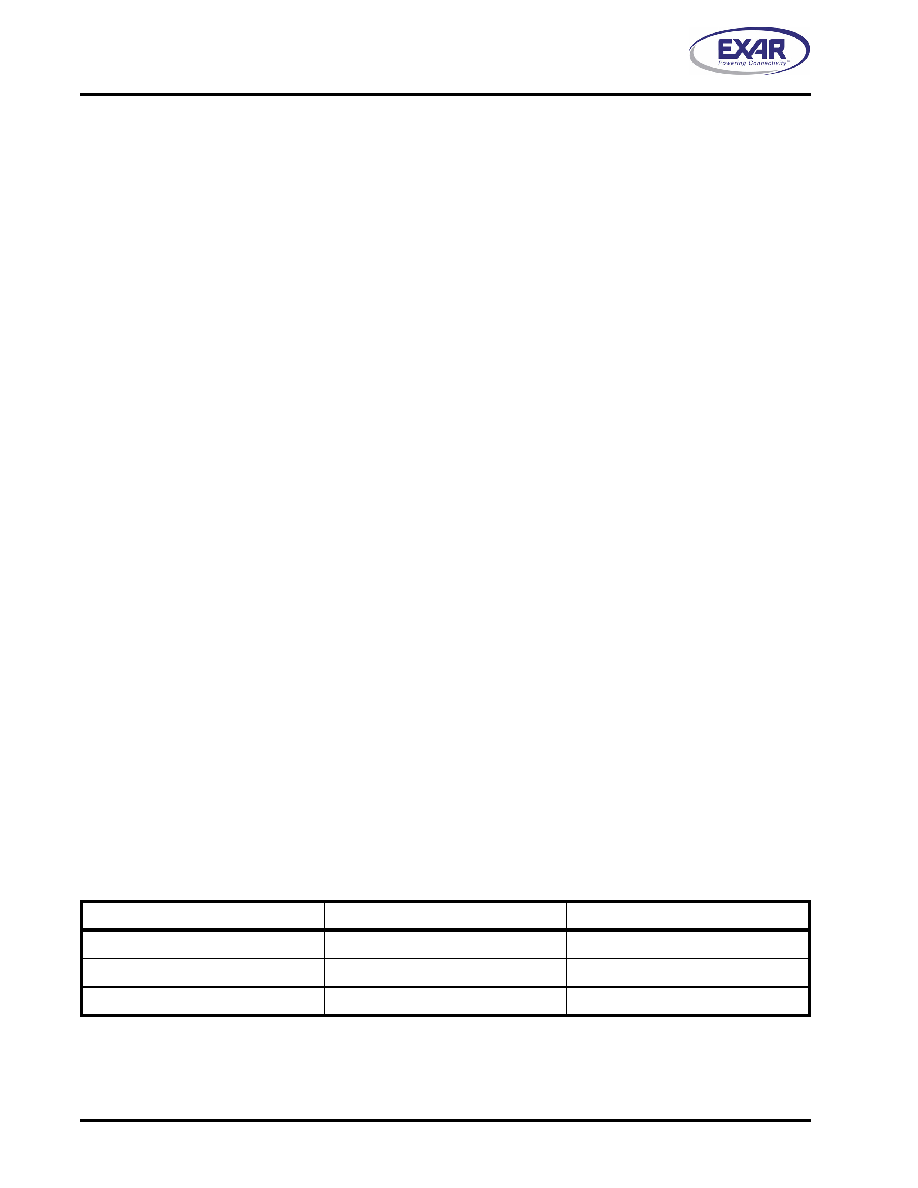- 您現(xiàn)在的位置:買賣IC網(wǎng) > PDF目錄16484 > XR16M670IL32-0B-EB (Exar Corporation)EVAL BOARD FOR XR16M670-B 32QFN PDF資料下載
參數(shù)資料
| 型號: | XR16M670IL32-0B-EB |
| 廠商: | Exar Corporation |
| 文件頁數(shù): | 30/50頁 |
| 文件大小: | 0K |
| 描述: | EVAL BOARD FOR XR16M670-B 32QFN |
| 標(biāo)準(zhǔn)包裝: | 1 |
| 系列: | * |
第1頁第2頁第3頁第4頁第5頁第6頁第7頁第8頁第9頁第10頁第11頁第12頁第13頁第14頁第15頁第16頁第17頁第18頁第19頁第20頁第21頁第22頁第23頁第24頁第25頁第26頁第27頁第28頁第29頁當(dāng)前第30頁第31頁第32頁第33頁第34頁第35頁第36頁第37頁第38頁第39頁第40頁第41頁第42頁第43頁第44頁第45頁第46頁第47頁第48頁第49頁第50頁

XR16M670
36
1.62V TO 3.63V HIGH PERFORMANCE UART WITH 32-BYTE FIFO
REV. 1.0.1
EMSR[2]: Send TX Immediately
Logic 0 = Do not send TX immediately (default).
Logic 1 = Send TX immediately. When FIFO is enabled and this bit is set, the next data will be to the TX shift
register. Thus, the data will be sent out immediately instead of queuing in the FIFO. Every time, only 1 byte
will be send out. Once this byte has been sent out, the EMSR[2] will go back to 0 automatically. If more than
1 byte will be sent out, EMSR[2] needs to be set to 1 for each byte.
EMSR[3]: Invert RTS in RS485 mode
Logic 0 = RTS# output is a logic 0 during TX and a logic 1 during RX (default).
Logic 1 = RTS# output is a logic 1 during TX and a logic 0 during RX.
EMSR[5:4]: Reserved
EMSR[6]: LSR Interrupt Mode
Logic 0 = LSR Interrupt Delayed (default). LSR bits 2, 3, and 4 will generate an interrupt when the character
with the error is in the RHR.
Logic 1 = LSR Interrupt Immediate. LSR bits 2, 3, and 4 will generate an interrupt as soon as the character is
received into the FIFO.
EMSR[7]: Xoff/Special character Interrupt Mode Select
This bit selects how the Xoff and Special character interrupt is cleared. The XON interrupt can only be cleared
by reading the ISR register.
Logic 0 = Xoff interrupt is cleared by either reading ISR register or when an XON character is received.
Special character interrupt is cleared by either reading ISR register or when next character is received.
(default).
Logic 1 = Xoff/Special character interrupt can only be cleared by reading the ISR register.
4.13
Baud Rate Generator Registers (DLL, DLM and DLD) - Read/Write
These registers make-up the value of the baud rate divisor. The M670 has different DLL, DLM and DLD for
transmitter and receiver. It provides more convenience for the transmitter and receiver to transmit data with
different rate. The M670 uses DLD[7:6] to select TX or RX. Then it provides DLD[5:0] to select the sampling
frequency and fractional baud rate divisor. The concatenation of the contents of DLM and DLL gives the 16-bit
divisor value. The value is added to DLD[3:0]/16 to achieve the fractional baud rate divisor. DLD must be
enabled via EFR bit-4 before it can be accessed. See Table 13 below and See ”Section 2.7, Programmable
DLD[5:4]: Sampling Rate Select
These bits select the data sampling rate. By default, the data sampling rate is 16X. The maximum data rate will
double if the 8X mode is selected and will quadruple if the 4X mode is selected. See Table 13 below.
TABLE 13: SAMPLING RATE SELECT
SAMPLING RATE
0
16X
0
1
8X
1
X
4X
DLD[5]
DLD[4]
相關(guān)PDF資料 |
PDF描述 |
|---|---|
| H3DKH-2036M | IDC CABLE - HKR20H/AE20M/HPK20H |
| VI-24V-EX | CONVERTER MOD DC/DC 5.8V 75W |
| A3DKB-1018M | IDC CABLE - AKR10B/AE10M/APK10B |
| RP60-4805SG/N | CONV DC/DC 60W 36-75VIN 05VOUT |
| A3DDB-2618G | IDC CABLE- AKR26B/AE26G/AKR26B |
相關(guān)代理商/技術(shù)參數(shù) |
參數(shù)描述 |
|---|---|
| XR16M670IL32-0C-EB | 功能描述:界面開發(fā)工具 Eval Board for XR16M670IL32 Series RoHS:否 制造商:Bourns 產(chǎn)品:Evaluation Boards 類型:RS-485 工具用于評估:ADM3485E 接口類型:RS-485 工作電源電壓:3.3 V |
| XR16M670IL32-F | 功能描述:UART 接口集成電路 1.8 HIGH PERFORMANCE UART W/32 RoHS:否 制造商:Texas Instruments 通道數(shù)量:2 數(shù)據(jù)速率:3 Mbps 電源電壓-最大:3.6 V 電源電壓-最小:2.7 V 電源電流:20 mA 最大工作溫度:+ 85 C 最小工作溫度:- 40 C 封裝 / 箱體:LQFP-48 封裝:Reel |
| XR16M670IL32TR-F | 制造商:Exar Corporation 功能描述:UART 1-CH 32Byte FIFO 1.8V/2.5V/3.3V 32-Pin QFN EP T/R 制造商:Exar Corporation 功能描述:XR16M670IL32TR-F |
| XR16M680 | 制造商:EXAR 制造商全稱:EXAR 功能描述:1.62V TO 3.63V HIGH PERFORMANCE UART WITH 32-BYTE FIFO |
| XR16M680IB25 | 制造商:EXAR 制造商全稱:EXAR 功能描述:1.62V TO 3.63V HIGH PERFORMANCE UART WITH 32-BYTE FIFO |
發(fā)布緊急采購,3分鐘左右您將得到回復(fù)。